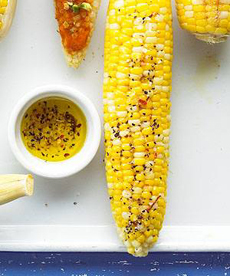TIP OF THE DAY: Corn On The Cob Toppings
 You can trade the butter for healthful olive oil. Photo courtesy CornTater.com. |
If you’re like most people, you spread butter on corn on the cob. It’s a tradition.
But traditions can be updated. If you like butter, consider adding flavor with a compound butter: chipotle butter, herb butter and numerous others (recipes). What if you want to avoid the calories and cholesterol? You’ve got tasty options: |
|
|
Would you like to add something to this list? IF IT’S FRESH, TRY IT PLAIN Immediately after harvesting, the sweet sugars that make corn so appealing begin to convert to starch. If the corn is several days old, there may not be much flavor left. So people pile on the condiments to add flavor. If the corn is fresh and sweet, it needs absolutely no topping. Try it: You may discover that nothing beats the pure, farm-fresh sweetness of a plain ear of corn. You can even eat it raw—something we do while waiting for the rest of the ears to cook. You can boil or microwave corn, but grilling enhances its sweetness. The heat caramelizes the sugar in the kernels. You can brush it with olive oil and then add the seasonings prior to grilling, or hold the seasonings altogether. |
||
|
SHOPPING FOR CORN
Many of us were taught by Mom to pull back the husk of the corn and look for….well, what are you actually looking for? There’s nothing to see but the size and color of the kernels (white, yellow, mixed), and that’s not going to impact your purchase decision. At worst, you’ll notice that a few kernels are missing at the very top of the ear. That’s not a defect: It’s how nature grew that particular ear. Pulling back the husks is the worst thing you can do. Exposing the kernels to air makes them dry out, and worse, spurs the conversion of the sugar to starch. You shouldn’t husk corn until right before cooking it. So forget what Mom said—she was only passing along bad information. Instead: |
 You should never peel back the husk—it speeds the conversion of the sugar to starch. The silk peeking out it is an indication of freshness. Photo courtesy eHow. |
|
|
Check the husks and the exposed corn silk (the tassel) for freshness. The more straw-colored/lighter the silk that peeks out from the husk, the fresher the corn. The exposed silk is the first thing to dry out and show age, as it turns to brown and black. That doesn’t mean an ear with black silk won’t be sweet—we’ve had plenty of delicious corn where the silk had turned black. It’s just an indicator: If you have a choice between ears with pale silk and those with dark silk, go for the pale. But if the tassel is missing, beware: It’s probably older corn, and the seller has peeled the outer husk leaves and removed the tassel to make it look better. Then, look at the husks. Are they bright green, or do they look drier and blotchy? Pale silk and bright husks are the answer to which ears you should pick. Now the big “however”: Chances are, all the corn you’re looking at in a store was harvested at the same time. The real choice lies at farmers markets or roadside stands, where you can compare the corn from different growers.
|
||


